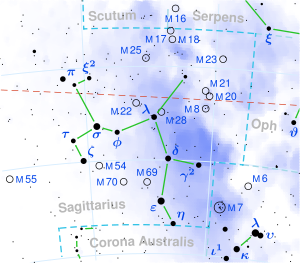Ross 154
Location of Ross 154 in the constellation Sagittarius | |
| Observation data Epoch J2000 Equinox J2000 | |
|---|---|
| Constellation | Sagittarius |
| Right ascension | 18h 49m 49.36378s[1] |
| Declination | –23° 50′ 10.4474″[1] |
| Apparent magnitude (V) | 10.44[2] |
| Characteristics | |
| Spectral type | M3.5V[2] |
| B−V color index | 1.76[3] |
| Variable type | Flare star[4] |
| Absolute magnitude (MV) | 13.07[2] |
| Details | |
Gyr | |
LHS 3414, V1216 Sagittarii.[9] | |
| Database references | |
| SIMBAD | data |
Ross 154 (V1216 Sgr) is a
Description
This star was first catalogued by American astronomer

Ross 154 was found to be a
A stellar classification of M3.5V[2] makes this a red dwarf star that is generating energy through the nuclear fusion of hydrogen at its core. It has an estimated 18% of the Sun's mass and 20% of the Sun's radius,[5] but it is radiating only 0.4% of the luminosity of the Sun.[5] In contrast to the Sun where convection only occurs in the outer layers, a red dwarf with a mass this low will be entirely convective.[18] Based on the relatively high projected rotation, this is probably a young star with an estimated age of less than a billion years.[7] The abundance of elements heavier than helium is about half that in the Sun.[7]
No low-mass companions have been discovered in orbit around Ross 154.
See also
References
- ^ S2CID 244398875. Gaia DR3 record for this source at VizieR.
- ^ a b c d e Staff (January 1, 2008), The One Hundred Nearest Star Systems, Research Consortium on Nearby Stars, archived from the original on May 13, 2012, retrieved 2008-06-12
- Bibcode:1972MNSSA..31....8C
- ^ Bibcode:1976IBVS.1221....1J
- ^ S2CID 235435757. 40.
- S2CID 16859859
- ^ S2CID 53357714
- ^
Ibañez Bustos, R. V.; Buccino, A. P.; Messina, Sergio; Lanza, A. F.; Mauas, P. J. D. (December 2020), "Activity-rotation in the dM4 star Gl 729. A possible chromospheric cycle", Astronomy & Astrophysics, 644, S2CID 226313606
- ^ "V* V1216 Sgr -- Flare Star", SIMBAD, Centre de Données astronomiques de Strasbourg, retrieved 2008-06-12
- ISBN 1-898563-02-0
- doi:10.1086/104790
- doi:10.1086/104699
- doi:10.1086/105447
- ^ "MAST: Barbara A. Mikulski Archive for Space Telescopes". Space Telescope Science Institute. Retrieved 8 December 2021.
- Bibcode:1953JRASC..47...23M
- Bibcode:1970IBVS..461....1C
- S2CID 17743657.
- S2CID 15159121
- S2CID 12737223
- S2CID 3498251
- ^ "Annotations on V* V1216 Sgr object". SIMBAD. Retrieved 2010-04-18.
- S2CID 55727428, archived from the original(PDF) on 2017-09-22, retrieved 2018-10-26
- Bibcode:1998larm.confE.115A
- doi:10.1086/111600
- S2CID 118374161
External links

